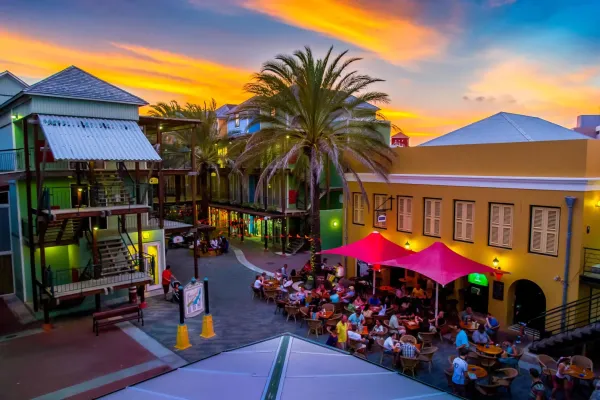Willemstad, Curaçao
Arriving in Willemstad, Curacao, feels like stepping into a postcard, with its iconic Handelskade waterfront lined by pastel-colored Dutch colonial buildings. We can stroll across the famous Queen Emma Pontoon Bridge, affectionately called “The Swinging Old Lady,” or explore the vibrant Punda and Otrobanda districts, where shops, galleries, and cafés invite us in. Willemstad’s unique blend of European and Caribbean cultures is reflected in its architecture, cuisine, and lively festivals.
A fascinating curiosity about Willemstad is that its colorful buildings were originally painted by law — in the 1800s, a governor complained that the sun’s glare on whitewashed walls gave him headaches, leading to the tradition of painting buildings in bright colors. We can visit the floating market, the Mikvé Israel-Emanuel Synagogue (the oldest in the Americas), or simply relax by the sea, enjoying Curacao’s crystal-clear waters and warm island spirit. Willemstad’s charm makes it a highlight of any Serenade of the Seas itinerary.

Breakfast in Pietermaai
Start your journey in Pietermaai, the neighborhood once known as a wealthy residential area for merchants and sea captains during the 18th and 19th centuries. Over time, it fell into disrepair but has since been reborn into Willemstad’s trendiest district. The colorful colonial mansions, lovingly restored, now house boutique hotels, street art galleries, and charming cafés. Begin your morning with a relaxed breakfast at one of the terraces here, where the pastel walls and bougainvillea vines offer a photogenic welcome to Curaçao’s capital.

Queen Emma Bridge
Walk to the famous Queen Emma Bridge, affectionately called “The Swinging Old Lady” by locals. Built in 1888, this floating pontoon bridge connects the Punda and Otrobanda districts and is the only one of its kind in the world that swings open sideways to let ships pass through St. Anna Bay. As you cross, you’ll be standing on a living symbol of Curaçao’s ingenuity and colonial-era architecture. Watching it swing open is a uniquely local experience and a great way to feel connected to the city’s maritime soul.

Handelskade & Fort Amsterdam
On the Punda side, you’ll immediately spot the world-famous Handelskade—a row of colorful Dutch colonial buildings lining the waterfront. These buildings date back to the 17th century when Curaçao became a center for shipping and trade under Dutch rule. A few steps away lies Fort Amsterdam, constructed in 1635 as the seat of Dutch West India Company power. Today, it serves as the governor’s office and includes a quaint church with cannonball damage still visible from an 1800 British attack—a striking reminder of the island’s colonial struggles.

Mikvé Israel–Emanuel Synagogue
Just a block inland is the Mikvé Israel–Emanuel Synagogue, built in 1732. This is the oldest continuously operating synagogue in the Western Hemisphere, and it reflects the significant Jewish heritage of Willemstad. Jewish immigrants fleeing persecution in Europe and Brazil found refuge in Curaçao and became influential in its development. The synagogue’s floor, famously covered in sand, represents the desert through which Moses and the Israelites wandered—and the secrecy of early worship under threat of persecution. It’s a peaceful, spiritual stop that showcases the city’s deep multicultural roots.

Kura Hulanda Museum –
Cross back to Otrobanda and visit the Kura Hulanda Museum, housed in a former merchant’s estate. It tells the sobering story of the transatlantic slave trade, of which Curaçao was a central hub. The museum houses African artifacts, harrowing exhibitions on slavery, and stories of resilience and cultural survival. While difficult, this visit adds a critical dimension to your understanding of the island’s true heritage—and Willemstad’s role in global history beyond its picture-perfect buildings.

Rif Fort & Waterfront Lunch
Next, enjoy lunch inside the revitalized Rif Fort, a 19th-century military structure that once protected the harbor from pirate and naval attacks. Today, the fort is home to restaurants, shops, and rooftop bars with panoramic views of the bay and Punda’s colorful facades. From seafood to Dutch-Caribbean fusion, you’ll find a variety of lunch options here, all accompanied by ocean breezes and live island rhythms. It’s the perfect midday pause in a space that seamlessly merges Curaçao’s military past with its cosmopolitan present.

Queen Wilhelmina Park & “CURAÇAO” Letters
After lunch, take a short walk to Queen Wilhelmina Park, a charming waterfront square named after the Dutch queen who ruled during Curaçao’s transition into the modern age. Here you’ll find the popular “CURAÇAO” and “DUSHI” signs, ideal for that must-have photo. “Dushi” is a Papiamentu word that means sweet, lovely, or nice—it sums up how locals describe life on the island. With flowers blooming and the sea sparkling nearby, this stop offers both beauty and a deep sense of national pride.

Floating Market & Downtown Shopping
Next, walk to the vibrant Floating Market, where Venezuelan merchants dock boats brimming with fresh fruits, fish, and vegetables. Though the market has shrunk in recent years due to political and economic changes in Venezuela, it still offers a rare glimpse of cross-Caribbean commerce. Continue to the nearby Breedestraat and Heerenstraat, pedestrian-friendly streets lined with Dutch-style storefronts and souvenir shops. Whether it’s Blue Curaçao liqueur, artisan crafts, or island spices, shopping here is an extension of Willemstad’s rich cultural blend.

Sunset Dinner at Fort Nassau
Cap off your day with dinner at Fort Nassau, a 1796 fortress perched on a hill overlooking the entire city and harbor. The views during golden hour are breathtaking, as the sun dips behind the Caribbean Sea and lights twinkle on across Willemstad. The restaurant offers fine dining in a historic setting, blending Dutch and Caribbean flavors with impeccable service. It’s a fitting final chapter to a day spent exploring a city where every cobblestone whispers stories of the past—and every flavor tastes like the island’s soul.




